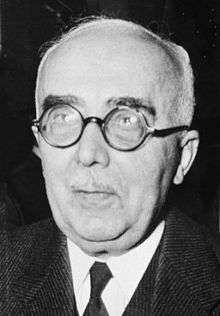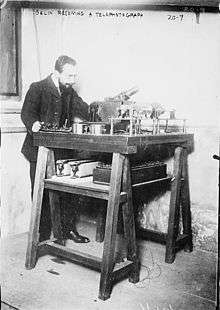Édouard Belin
Édouard Belin (Vesoul, Haute-Saône, France, 5 March 1876 – 4 March 1963 in Territet, Canton of Vaud, Switzerland) was a French photographer and inventor. In 1907 Belin invented a phototelegraphic apparatus called the Bélinographe (télestéréographe)—a system for receiving photographs over telephone wires via telegraphic networks.[1]


Belin's invention had been used for journalistic photos since 1914, and the process was improved by 1921 to enable transmission of images by radio waves.[2]
From 1926, Belin worked on an television apparatus. In 1926, with Holweg, he tested the capacity for the eye to perceive pictures proposed at a very high speed, using a mirror drum.[3]
Belin was a president of the French Company of photography.
Bélinographe
In this apparatus, the transmitter traverses the original image point by point. At each point a measurement of light intensity is made with an electric eye. The measurement is conveyed to the receiver. There, a variable intensity light source reproduces the light measured by the electric eye, while carrying out same displacements exactly. By doing this, it exposes the photographic paper and makes it possible to obtain a copy of the original image.
Other scientists such as Arthur Korn had also been developing technology to transmit images over long distances.[4]
Modern telecopiers and photocopiers use the same principle, with this close the sensor of light intensity was replaced by a sensor CCC, and that the device of impression is based on the laser technology, and either photographic.
Legacy
Belin gave his name to a high school of Vesoul, Haute-Saône, France.[5]
See also
References
- Edward Jewitt Wheeler (1908). "Picture Telegraphy on an Entirely Novel Principle". Current Literature: 1908. Current Literature Publishing Company. pp. 436–437. Retrieved 2 July 2014.
- Wilfred S. Ogden (December 1921). "How the World's First Wireless News-Picture Was Flashed Across the Atlantic Ocean, Paris get President Harding's portrait in twenty minutes". Popular Science. Bonnier Corporation. pp. 21–22. ISSN 0161-7370. Retrieved 2 July 2014.
- "L'impact de la roue à miroirs 1920-1929", Site Histoire de la télévision
- Solbert, Oscar N.; Newhall, Beaumont; Card, James G., eds. (September 1953). "Photos by Wire" (PDF). Image, Journal of Photography of George Eastman House. Rochester, N.Y.: International Museum of Photography at George Eastman House Inc. 2 (6): 35. Archived from the original (PDF) on 14 July 2014. Retrieved 26 June 2014.
- Lycée Edouard Belin. missiontice.ac-besancon.fr
External links
| Wikimedia Commons has media related to Édouard Belin. |